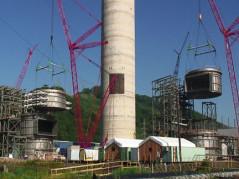The B&W Learning Center
Leading the world in clean power production technology
Engineered Approaches in Construction

Engineered Approaches in Construction, and Construction Methods
Taking an engineered approach to the execution of heavy lifts requires the use of specialized tools, equipment, rigs, jigs and fixtures.
Modern construction methods include modularized components that are erected on short timetables. To reduce construction and shipping costs, leaner designs of support steel components have become the norm. As a result, the calculation of imposed erection loads has become even more critical.
Customer specifications have required the submittal of engineered rigging drawings and procedures prior to construction. These submittals often require the stamp of a licensed professional engineer.
Construction methods
There are three basic approaches that may be used in a construction project:
- knocked down (the traditional method),
- field modularization, and
- shop modularization.
The knocked-down approach is based on the erection of shop-fabricated, standard-sized shipping units that readily fit on a truck/trailer or rail car. The standard shipping units are erected one piece at a time in stick fashion. Field modularization combines these traditional ship units into larger sub-assemblies, or modules, at the construction site for final installation. Off-site assembly, shop modularization, or prefabrication combine the traditional ship units into subassemblies at the manufacturing plant.
Modularization is an integrated approach to power plant construction whose concepts must be incorporated at the earliest possible planning stages of a project. The most successful projects have ongoing commitment to this approach by the customer, the equipment supplier, and the erecting contractor.
While modularization may be cost effective, the extent of effective modularization is site specific. Modularization divides plant materials into subsets, or modules, that are assembled before being brought to the construction site. The degree and extent of modularization can vary considerably. In its simplest form, a structural steel beam with shop-attached clip angles is an assembly. Alternatively, a shop-assembled boiler complete with all trim piping, instrumentation, and insulation and lagging, or a 50 t (45.4 tm) section of ductwork insulated and lagged is also considered a module.
Boiler components have been modularized for some time. Fig. 1 depicts a steam generating bank being lifted in preparation for installation. Large modularized scrubber components are shown in Fig. 2.

Fig. 2
A modularized project requires more engineering and design time than a conventional project. Planning must consider the water and land routes used for shipping the modules. Construction sites located on navigable waterways have the greatest potential for shipment of large modularized components.
Module unloading, site movements and erection procedures must be carefully considered. Special consideration must also be given to foundations, backfilling and compacting at the site. Other concurrent site activities must be evaluated when planning for modularization.
Construction participation by all involved parties is required for planning any project to enhance constructability and identify intended erection methods. The erection method is influenced by the following factors:
- Retrofit versus new plant installation
- Plant arrangement
- Scope
- Parameters
- Site conditions
- Contractor interface
- Schedule
- Extent and location of field welds